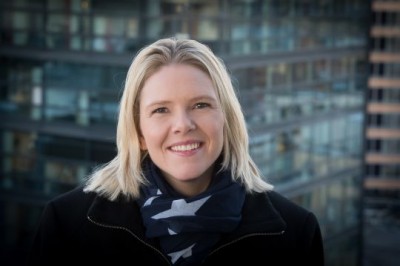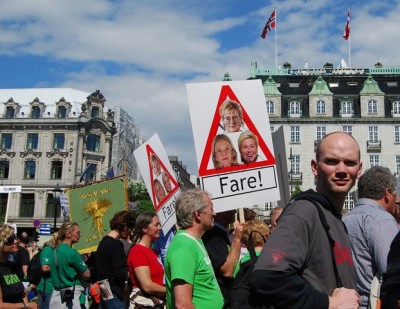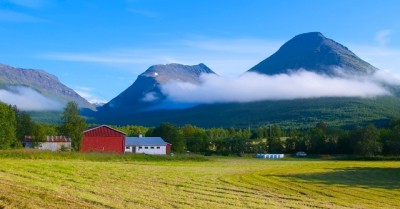Just days after the International Monetary Fund scolded Norway over its high food prices, the country’s new conservative government coalition finally secured support in Parliament for its plan to reform agricultural policies that help keep Norway’s food the most expensive in the world. Agriculture Minister Sylvi Listhaug claimed victory, even though it cost her another NOK 250 million in ongoing state support.

Representatives for Listhaug’s Progress Party, her government coalition partner, the Conservatives, and their two support parties in Parliament, the Christian Democrats and the Liberals, signed a deal late Wednesday that assures them passage of what Listhaug called “the most comprehensive simplification” of Norwegian agricultural policy that’s ever been achieved.
“I’m glad that we have got in place a future-oriented agricultural settlement that rewards farmer who want to live off of being a farmer, and who generate their main income off the farm and want to invest in developing sustainable operations,” Listhaug said in a statement issued by her ministry Wednesday evening, just before many Norwegians took off for a four-day weekend tied to Ascension Day on Thursday. “Now the farmers can decide more themselves, and the state will decide less. Full-time farmers will get a better economic base. I think that’s reasonable and most fair.”

Listhaug has been caught in a nasty conflict with Norway’s two most powerful lobbying organizations for the farmers, which accused her of trying to “industrialize” farming by favouring large farms in areas closer to population centers over small ones in remote areas. She has proposed reform of production quotas and price controls that would allow the large farmers to produce more, and thereby take advantage of economies of scale, while the farmers’ organizations claim that will come at the expense of small farmers.
Most small farmers have never been able to make a living off their tiny plots of land, even though they’ve received subsidies and benefited from Norway’s strict regulation of farming for years. The support has also helped them to invest in equipment like large tractors, that often are used for other paid work such as snow-plowing in the winter. These farmers, who also contend that their picturesque properties contribute to Norway’s cultural landscape, have been among those protesting mightily to retain their state support.
Listhaug initially offered an extra NOK 150 million in state support for farmers, in addition to the NOK 13 billion they already receive, but also demanded that larger-scale farmers be allowed to boost their production. For years, production has been restricted in order to keep prices high. Norwegian Broadcasting (NRK) reported that the deal cut Wednesday with the Christian Democrats and Liberals adds another NOK 250 million in support, but Listhaug insisted that it retained the framework for reforms she has proposed.

“This agreement represents a new direction in agricultural policy,” Listhaug said. “Those who want to live off their farms and work full-time will get better prospects for revenues.” She’s well aware that Norwegians have a tradition of willingly supporting their farmers, but she’s ushering in changes in how that support is distributed.
Ingunn Foss of the Conservatives, Listhaug’s government partner, chided opposition parties that tried to derail the government’s annual offer to farmers, which their lobbying organizations had rejected. The newly agreed policy was decided by the government and its two support parties, Foss said, “not another party here in Parliament,” referring to the rival Labour Party. Labour had been accused earlier this week of being more eager to cause problems for the Progress Party and Listhaug than in constructively trying to improve Norwegian agriculture. “My impression has been that many of these (opposition) politicians aren’t thinking about how they can contribute to more profitable farming in Norway,” Ivar Gaasland, an economist and agriculture researcher at the University of Bergen, told newspaper Dagsavisen. “They’re more concerned with party politics and posturing.”
Morten Ørsal Johansen of the Progress Party said the agreement was the result of “constructive negotiations” with the Christian Democrats and Liberals, but noted they already had met criticism from the farmers’ organizations. “The agreement will lead to increased food production in Norway,” Johansen said. “When the farmers complain, it just shows we have done something right.”
While the main farmers’ lobbies (Norges Bondelag and Norsk Småbrukarlag) objected to the proposed reforms to their strictly regulated production and pricing, several other farmers have spoken out in favour of them. Some had even cancelled their membership in the farmers’ organizations, contending they were old-fashioned and stuck in Norway’s long history of heavy regulation and market controls that have resulted in Norway having among the highest food prices in the world.
IMF blasts Norway’s ‘inefficient district politics’
The International Monetary Fund (IMF), meanwhile, lashed out at Norway earlier this week, claiming the country’s high food prices punish consumers who have the lowest incomes. The farmers repeatedly have pointed out that average Norwegians use a lower percentage of their household budgets on food than consumers in many other countries, but the IMF stressed that doesn’t help low-income Norwegians who must pay around NOK 30 (USD 5) in Oslo for a loaf of bread and NOK 15 (USD 2.50) for a quart of milk. A dozen eggs in Norway costs around USD 7 while a boneless lamb roast serving four persons costs well over NOK 400 (USD 66).
The impact of Norway’s food prices, recently shown in a survey by Eurostat and Norway’s state statistics bureau SSB to be 86 percent higher than average prices in the European Union’s 27 member nations, thus hits lower income residents much harder. Tom Dorsey, leader of an IMF delegation that visited Norway’s Finance Ministry last week, stressed to newspaper Dagens Næringsliv (DN) that while Norwegian food prices are often double those elsewhere in Europe, prices in Europe are in turn considerably higher than in the rest of the world.
Dorsey acknowledged that much of the reason for Norway’s high, protectionist tariffs on cheaper food imports and its high subsidy level is based on efforts to help small farmers in remote areas who face difficult farming conditions. Such efforts to breathe life into the far-flung districts of Norway, Dorsey claimed however, are misguided and inefficient.
“It makes all food more expensive, in order for Norwegian-produced food to compete,” Dorsey said. “You raise the cost of all food that could potentially compete with Norwegian food, even though the Norwegian food makes up a small portion of the total. That’s an extremely inefficient means of supporting your farmers. If the goal is to support far-flung districts, more direct subsidy to them would be far more preferable.”
He realized that politically, though, it’s much easier for Norwegian politicians to uphold high import barriers, than to blatantly hand over lots of taxpayers’ cash to specific farmers in the state budget. “The farmers know very what’s going on, and how they benefit from the current system,” Dorsey said. “They’re already getting large amounts of money from the state, it’s just more hidden.”
newsinenglish.no/Nina Berglund

